family memories

 It’s always strange to look back and realize that a loved one has been in Heaven for a year. The subsequent years aren’t as shocking, at least until your reach the milestones like 5, 10, or more. That strange realization is where I find myself today, the one year anniversary on my mother-in-law, Joann Schulenberg’s passing.
It’s always strange to look back and realize that a loved one has been in Heaven for a year. The subsequent years aren’t as shocking, at least until your reach the milestones like 5, 10, or more. That strange realization is where I find myself today, the one year anniversary on my mother-in-law, Joann Schulenberg’s passing.
Over the years, much changed with my mother-in-law. She was, from the time I first met her, a stubborn woman, and I suppose that many people might take that to mean annoying, but she wasn’t. People might disagree with me, but in my opinion, the type of stubbornness that she had is a good form, because it is more of an “if at first you don’t succeed, try, try again” type of stubbornness. In fact, she and I are probably very much alike in our stubbornness, and quite possibly, that is part of the reason we always got along so well. She was a wonderful mother-in-law. My mother-in-law taught herself to master many types of crafts, including quilting, crocheting, knitting, sewing, and canning. These things served her family well over the years. Her crafts proving them with things they needed, and she made money on them too.
As Alzheimer’s began to rob her of much of her recent memory, she became more confused, but I believe that she and we handled it well. She became quite funny. Never one to joke much, she suddenly had a kind of dry humor that I can really relate to. She would surprise me with her quick comebacks, at a time that I thought she didn’t know what was going on, or who I was. Fooled me every time!! Whether she knew she had fooled me, somehow did it on purpose, or simply stated a fact as she saw it at that moment, it was always funny.
In all of the 11 years that I took care of her, my mother-in-law was really a joy to be around, even when she fought with me periodically. The time I spent taking care of her was as rewarding as the time I spent taking care of the rest of the parents. End of life care is really what you make of it. The person is always so grateful to you for your help, and there is a bond with them that will forever change them both. You can’t spent that many hours with your mother-in-law, and not feel a closeness to her. She told me about things in the past, and really enriched my understanding of my husband’s genealogy. She may not have even realized the impact that our conversations had on me, but they were like pure gold. Priceless, and a gift that I will cherish forever. Joann Knox Schulenberg lived a very interesting life, and one that was very different from my own. She was the 
 mother of my husband, Bob, and the way she raised her children, enriched my life too. She taught them to be loyal, hard working people, who had self esteem and were respectful to others. She taught them to be kind and helpful to those in need. She raised her family to be close friends, and to share their talents for the good of all. They have always worked together on things. What more could a daughter-in-law ask of her mother-in-law? Mom, most of all, you were a true friend to me, and I miss you very much. I can’t believe that it has already been a year since you left us.
mother of my husband, Bob, and the way she raised her children, enriched my life too. She taught them to be loyal, hard working people, who had self esteem and were respectful to others. She taught them to be kind and helpful to those in need. She raised her family to be close friends, and to share their talents for the good of all. They have always worked together on things. What more could a daughter-in-law ask of her mother-in-law? Mom, most of all, you were a true friend to me, and I miss you very much. I can’t believe that it has already been a year since you left us.
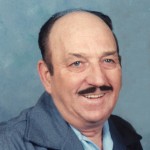 Time waits for no man, and it doesn’t slow down or stop while we grieve a loss. As a child and on into adulthood, it never occurred to me that I would live one single day without my dad. I can’t say why I thought that, because in retrospect, it was not really a logical way to think, but then are matters of the heart ever logical. It doesn’t matter if you are talking about romantic love or the love you have for parents or siblings. They should just never leave you, whether that is logical or not.
Time waits for no man, and it doesn’t slow down or stop while we grieve a loss. As a child and on into adulthood, it never occurred to me that I would live one single day without my dad. I can’t say why I thought that, because in retrospect, it was not really a logical way to think, but then are matters of the heart ever logical. It doesn’t matter if you are talking about romantic love or the love you have for parents or siblings. They should just never leave you, whether that is logical or not.
Nevertheless, as illogical as it seemed to me, my dad, Al Spencer went home to be with the Lord eleven years ago today December 12, 2007 at precisely 12:00pm. The world seemed so empty when we left the hospital that day, and I found myself wondering how it could be that the world and time kept moving when everything for my dad stopped at that moment. Again these were not the thoughts of a person in a rational state of mind,but rather a person who had just lost a beloved parent. I knew that my dad was in Heaven,because he had always believed in Jesus as his Saviour, but he was no longer here with us…his wife, Collene Spencer; daughters, Cheryl Masterson, Caryn Schulenberg, Caryl Reed, Alena Stevens, and Ally Hadlock; and their families, and that was what made the whole world…just wrong.
As the years go by…faster than any of us ever dreamed they would, we cherish the memories of our dad more and more,because they are all we have…because our dad and our mom are in our future now. My thoughts go back to the many times my girls, Corrie Petersen and Amy Royce and I had lunch at their house. It’s odd, I suppose that those lunches are what comes to mind, but they have been coming to my mind a lot these past 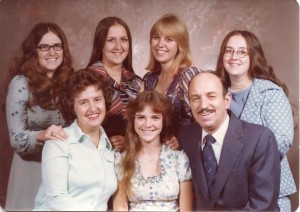 few days. I remember going over to their house at lunch. Mom would make her specialties, Stuffed Tomatoes or Chicken salad with Shoe String Potatoes. As we gathered at the table to eat, the conversation covered everything from our families to how our jobs were going. Mom and Dad didn’t care what we talked about, they just wanted to be a part of our lives. Mom and Dad were always all about family. They loved their kids, grandkids, great grandkids, and great great grandkids. They felt so blessed by the family they started beginning back in 1954. Family was all they ever wanted. Family was everything. I still can’t believe that my dad has been in Heaven for eleven years today. We love you Dad, and miss you very much. We will see you in Heaven one day.
few days. I remember going over to their house at lunch. Mom would make her specialties, Stuffed Tomatoes or Chicken salad with Shoe String Potatoes. As we gathered at the table to eat, the conversation covered everything from our families to how our jobs were going. Mom and Dad didn’t care what we talked about, they just wanted to be a part of our lives. Mom and Dad were always all about family. They loved their kids, grandkids, great grandkids, and great great grandkids. They felt so blessed by the family they started beginning back in 1954. Family was all they ever wanted. Family was everything. I still can’t believe that my dad has been in Heaven for eleven years today. We love you Dad, and miss you very much. We will see you in Heaven one day.
 During World War II, it seems that there were a number of missed warnings about coming actions. Perhaps, if these warnings had been heeded, parts of the war, and indeed the length of it might have been different. One such event occurred when two German officers who were flying after consuming too much alcohol, became lost in the inky black night sky, when suddenly their plane began to nosedive. Maybe they thought, as their doomed plane plunged toward the ground, “Please let this be German soil we’re hurtling towards.” No matter what their thoughts were, they were definitely not headed for a crash landing in Germany, but rather they crashed in Holland.
During World War II, it seems that there were a number of missed warnings about coming actions. Perhaps, if these warnings had been heeded, parts of the war, and indeed the length of it might have been different. One such event occurred when two German officers who were flying after consuming too much alcohol, became lost in the inky black night sky, when suddenly their plane began to nosedive. Maybe they thought, as their doomed plane plunged toward the ground, “Please let this be German soil we’re hurtling towards.” No matter what their thoughts were, they were definitely not headed for a crash landing in Germany, but rather they crashed in Holland.
The crash landing in Holland was a big problem for the officers, because they were carrying battle plans for Hitler’s coming invasion of Holland. The plans, which involved exotic strategies like flamethrowers, and using gliders to silently deliver troops behind enemy lines, all seemed so unlikely that the  Dutch commanders refused to believe it. Just weeks later, it all unfolded exactly as the plan had foretold. Germany occupied Holland. It seems incredible but almost every daring German offensive was known well beforehand. Yet, in every case, those in power refused to see what was right in front of them. Hitler could have been stopped long before he was, if these botched early warnings had been taken seriously. In another such example, a German deserter was captured by the Russians. He gave up the plans to Hitler’s “Operation Barbarossa.” Yet, the Russian commanders found the 1,800 mile wide offensive too unlikely to believe. Then, just weeks later, they were caught off guard by the largest invasion in history.
Dutch commanders refused to believe it. Just weeks later, it all unfolded exactly as the plan had foretold. Germany occupied Holland. It seems incredible but almost every daring German offensive was known well beforehand. Yet, in every case, those in power refused to see what was right in front of them. Hitler could have been stopped long before he was, if these botched early warnings had been taken seriously. In another such example, a German deserter was captured by the Russians. He gave up the plans to Hitler’s “Operation Barbarossa.” Yet, the Russian commanders found the 1,800 mile wide offensive too unlikely to believe. Then, just weeks later, they were caught off guard by the largest invasion in history.
But, perhaps the most chilling warning of all came far earlier: before the war had even started. The warning came from an analyst dispatched to Hitler’s Germany in 1938. In 1939 he delivered a sobering prediction: the worst conflict in history was about to begin. He reported: “War is coming to Europe, but not until September at the earliest.” On September 1, 1939, Hitler launched his attack on Poland. World  War II had begun. That analyst belonged to a group that soon became part of the largest underground news and research network in the world. One that would go on to predict large world shifts with shocking accuracy: As early as 1987, this network predicted the fall of the Soviet Union. In 1989, they called the crash of the Japanese “miracle.” In the early 90s, they spoke out about the threat of radical Islamic terrorism. In the mid 2000s, they predicted the 2008 financial meltdown. They also predicted Donald Trump’s improbable win in the 2016 Presidential race, which in my opinion was their best prediction. Sadly, this underground news and research group, was not taken seriously in the warnings they gave, and the world paid the consequences for those missed warnings.
War II had begun. That analyst belonged to a group that soon became part of the largest underground news and research network in the world. One that would go on to predict large world shifts with shocking accuracy: As early as 1987, this network predicted the fall of the Soviet Union. In 1989, they called the crash of the Japanese “miracle.” In the early 90s, they spoke out about the threat of radical Islamic terrorism. In the mid 2000s, they predicted the 2008 financial meltdown. They also predicted Donald Trump’s improbable win in the 2016 Presidential race, which in my opinion was their best prediction. Sadly, this underground news and research group, was not taken seriously in the warnings they gave, and the world paid the consequences for those missed warnings.
 Anytime a group of people goes on strike, there are side effects that go beyond the management having to do more work. One of the industries in which a strike can have devastating side effects is the airline industry. When air traffic controllers strike, and the people filling in for them are not used to doing that job, even if they are trained, things can get out of hand quickly. They are likely understaffed, and stressed, but you can’t let these planes fly without guidance, so you use people in management, who probably haven’t done this work in a long time. Such was the case on March 5, 1973, over France when two Spanish aircraft, a DC9 and a Coronado 990 collided 27,000 feet above Nantes, in western France.
Anytime a group of people goes on strike, there are side effects that go beyond the management having to do more work. One of the industries in which a strike can have devastating side effects is the airline industry. When air traffic controllers strike, and the people filling in for them are not used to doing that job, even if they are trained, things can get out of hand quickly. They are likely understaffed, and stressed, but you can’t let these planes fly without guidance, so you use people in management, who probably haven’t done this work in a long time. Such was the case on March 5, 1973, over France when two Spanish aircraft, a DC9 and a Coronado 990 collided 27,000 feet above Nantes, in western France.
Sixty eight people were killed when the two Spanish aircraft collided in mid-air over France that morning,  where air traffic controllers are on strike. The dead, who included a two year old child and 47 Britons, were on board a Spanish Airlines DC9 from Palma, Majorca to London. Eye witnesses said that the DC9 exploded and broke up in mid-air following the collision. Max Chevalier, British Honorary vice-consul at Nantes, said, “Suddenly a streak of red light appeared and part of the aircraft came down with bodies flying out. It was a horrible sight.”
where air traffic controllers are on strike. The dead, who included a two year old child and 47 Britons, were on board a Spanish Airlines DC9 from Palma, Majorca to London. Eye witnesses said that the DC9 exploded and broke up in mid-air following the collision. Max Chevalier, British Honorary vice-consul at Nantes, said, “Suddenly a streak of red light appeared and part of the aircraft came down with bodies flying out. It was a horrible sight.”
The pilot of the Coronado 990, Captain Antonio Arenas-Rodriguez, was able to land his damaged aircraft safely at a military airfield in Cognac. All 108 people on board survived without injury. A passenger on board the Coronado aircraft, Leonard Wareham, 59, who lives in Madrid, said, “We were sitting on the port side of the aircraft. My wife had the window seat. There was an enormous bump and then everything seemed to fall about. No-one knew what was happening except that the aircraft was falling fast. The next thing I  noticed was that a French fighter plane was flying around us and evidently he guided us in to land.”
noticed was that a French fighter plane was flying around us and evidently he guided us in to land.”
At least 16 airlines, including British European Airlines (BEA) and Caledonian, cancelled flights over France following news of the accident. Members of the French Civilian Air Controllers Association (SNCTA), have been on strike illegally since February 20, 1973 hoping to gain improved pension benefits and obtain the right to strike which was outlawed for air traffic controllers in 1964. Military air traffic controllers were put in place to operate France’s air control system on February 26.

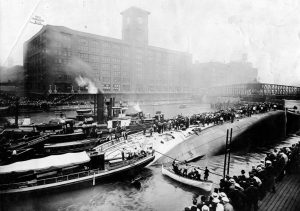 Shipwrecks on the Great Lakes are not a totally uncommon event. Over the last 300 years, Lake Michigan has claimed countless ships, mostly in violent storms and bad weather, especially when the gales of November come in. Nevertheless, a few ships went down without even reaching open waters. One of those ships was the SS Eastland, which went down while docked between LaSalle and Clark Streets on the Chicago River. That site and that ship became the site of the greatest loss of life on the Great Lakes, and it wasn’t a fire, explosion, or act of war, but rather something far more strange.
Shipwrecks on the Great Lakes are not a totally uncommon event. Over the last 300 years, Lake Michigan has claimed countless ships, mostly in violent storms and bad weather, especially when the gales of November come in. Nevertheless, a few ships went down without even reaching open waters. One of those ships was the SS Eastland, which went down while docked between LaSalle and Clark Streets on the Chicago River. That site and that ship became the site of the greatest loss of life on the Great Lakes, and it wasn’t a fire, explosion, or act of war, but rather something far more strange.
The SS Eastland was built by the Michigan Steamship Company in 1902 and began regular passenger service later that year. In July 1903, the ship held an open house so the public could have a look. The sudden number of people, particularly on the upper decks, caused the Eastland to list so severely that water came in through the gangways where passengers and freight would be brought aboard. The ship was obviously top-heavy and this problem had to dealt with quickly, but these incidences continued to plague the ship. In 1905, the Eastland was sold to the Michigan Transportation Company. During the summer of 1906, the Eastland listed again as it transported 2500 passengers, and her carrying capacity was reduced to 2400. But in July 1912, the Eastland was reported as having once more listed to port and then to starboard while carrying passengers. In 1915, the LaFollette Seaman’s Act, which was created as a response to the Titanic not carrying sufficient lifeboats, was passed. The Seaman’s Act mandated that lifeboat space would no longer depend on gross tonnage, but rather on how many passengers were on board. However adding extra weight to the ship put top-heavy vessels like the Eastland at greater risk of listing. In fact, the Senate Commerce Committee was cautioned at the time that placing additional lifeboats and life rafts on the top decks of Great Lakes ships would make them dangerously unstable. This was a warning that the Senate Committee and the Eastland should have heeded.
On July 24, 1915, the Eastland once again fell victim to its top heavy design, and this time the outcome was disastrous. On that cool Saturday morning in Chicago, the Eastland and two other steamers were waiting to take on passengers bound for an annual company picnic in Michigan City, Indiana. For many of the employees of Western Electric Company’s Hawthorne Works, this would be the only holiday they would enjoy all year. A large number of these employees from the 200-acre plant in Cicero, Illinois were Czech Bohemian immigrants. Excitement was in the air as thousands of employees thronged along the river. Three ships would transport them across Lake Michigan to the picnic grounds in Indiana. The Eastland was slated to be the first ship boarded. That morning the Eastland was docked between LaSalle and Clark Streets on the Chicago River. As soon as passengers began boarding, Captain Harry Pedersen and his crew noticed that the ship was listing to port even though most passengers were gathered along the starboard. Attempts were made to right the vessel, but stability seemed uncertain. At 7:10am, the ship reached its maximum carrying capacity of 2572 passengers and the gangplank was pulled in.
As the captain made preparations to depart at 7:21am, the crew continued to let water into the ship’s ballast tanks in an attempt to stabilize the vessel. At 7:23am, water began to pour in through the port gangways. Within minutes, the ship was seriously listing but most passengers seemed unaware of the danger. I wondered how this could have continued to happen, until I saw this video, that explained it very well. By 7:27am, the ship listed so badly that passengers found it too difficult to dance so the orchestra musicians started to play ragtime instead to keep everyone entertained. Just one minute later, at 7:28am, panic set in. Dishes crashed off shelves, a sliding piano almost crushed two passengers, and the band stopped playing as water poured through portholes and gangways. In the next two minutes, the ship completely rolled over on its side, and settled on the shallow river bottom 20 feet below. Passengers below deck now found themselves trapped as water gushed in and heavy furniture careened wildly. Men, women and children threw themselves into the river, but others were trapped between decks, or were crushed by the ship’s furniture and equipment. The lifeboats and life jackets were of no use since the ship had capsized too quickly to access them. In the end, 844 people lost their lives, including 22 entire families. It was a tragedy of epic proportions.
Bystanders on the pier rushed to help those who had been thrown into the river, while a tugboat rescued passengers clinging to the overturned hull of the ship. An eyewitness to the disaster wrote: “I shall never be able to forget what I saw. People were struggling in the water, clustered so thickly that they literally covered 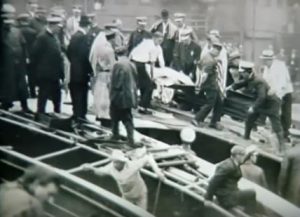
 the surface of the river. A few were swimming; the rest were floundering about, some clinging to a life raft that had floated free, others clutching at anything that they could reach…at bits of wood, at each other, grabbing each other, pulling each other down, and screaming! The screaming was the most horrible of them all.” Yes, I’m sure that was the worst, and the loss of life was something that would never be forgotten…especially for an eye witness.
the surface of the river. A few were swimming; the rest were floundering about, some clinging to a life raft that had floated free, others clutching at anything that they could reach…at bits of wood, at each other, grabbing each other, pulling each other down, and screaming! The screaming was the most horrible of them all.” Yes, I’m sure that was the worst, and the loss of life was something that would never be forgotten…especially for an eye witness.

 My son-in-law, Travis Royce is without a doubt, the most social person in our family. Travis can talk to anyone. There isn’t a shy bone in his body. I think that is one thing that made him such a great DJ when he and my daughter, Amy lived here in Casper. Travis was born in San Diego, and spent a number of years in Puyallup, Washington as a child. He loved it there, and loves the coastal areas in general, so after their children graduated from high school, they made the move to the Seattle area, and now to the Bellingham area. They truly love the area, and I can understand that, because it is quite beautiful there. I don’t know if would love the rain, but they seem to, so it’s all good.
My son-in-law, Travis Royce is without a doubt, the most social person in our family. Travis can talk to anyone. There isn’t a shy bone in his body. I think that is one thing that made him such a great DJ when he and my daughter, Amy lived here in Casper. Travis was born in San Diego, and spent a number of years in Puyallup, Washington as a child. He loved it there, and loves the coastal areas in general, so after their children graduated from high school, they made the move to the Seattle area, and now to the Bellingham area. They truly love the area, and I can understand that, because it is quite beautiful there. I don’t know if would love the rain, but they seem to, so it’s all good.
Travis can make friends wherever he goes, and he loves to entertain…especially with a barbeque. He loves to go all out with the feast he puts on too. He might cook steaks, lobster, or jalapeno poppers…or just burgers. No matter what’s cooking Travis is a good cook, and he is a great host. As I said, he loves to entertain, and he is quick witted, so there is never a dull moment. When Travis is around, there is always a joke going on. Even when my daughter, Amy and Travis aren’t entertaining, they love to sit out in their back yard with a fire going, just enjoying the peace and quiet. Their home is out in the country…or at the edge of town anyway, so it is quiet a quiet neighborhood.
Now you might think that with their love of the country life, quiet would be the order of the day, but that is not always the case. As summer approaches, both Amy and Travis look forward to getting out their motorcycle 
 and cruising the area. With all of the water destinations in their vicinity, they have a lot of pretty drives that they can take. Travis is definitely not a snow lover, so Western Washington is pretty ideal. He wants as many warm months as possible. I can relate to that, but I don’t know that Washington is the ideal place. Still, as Amy says, they don’t like the extreme heat either, so there you have it. All I care about is that Travis loves my girl, and he does. Today is Travis’ birthday. Happy birthday Travis!! Have a great day!! We love you!!
and cruising the area. With all of the water destinations in their vicinity, they have a lot of pretty drives that they can take. Travis is definitely not a snow lover, so Western Washington is pretty ideal. He wants as many warm months as possible. I can relate to that, but I don’t know that Washington is the ideal place. Still, as Amy says, they don’t like the extreme heat either, so there you have it. All I care about is that Travis loves my girl, and he does. Today is Travis’ birthday. Happy birthday Travis!! Have a great day!! We love you!!
 The older I get, the more that I know that Heaven is my true home. Never is that fact more clear, than on Resurrection Sunday, because whether we know the exact day or not, we know that it was that day that the Christians first knew that they were truly right with God again. Many people have disputed the celebration of Easter, or Resurrection Sunday, saying that it’s roots were in paganism, but I have to say that I refuse to give the devil any day on this earth. I know why I celebrate Easter. It’s not because of a bunny, but because of a lamb. Jesus is the Lamb of God…the sacrifice that paid for the sins of the world…past, present, and future. And now, because He lives, I know that I can face tomorrow. It is because of the grace of God…the unearned, unmerited favor and mercy of a loving God that I get to spend eternity in Heaven with
The older I get, the more that I know that Heaven is my true home. Never is that fact more clear, than on Resurrection Sunday, because whether we know the exact day or not, we know that it was that day that the Christians first knew that they were truly right with God again. Many people have disputed the celebration of Easter, or Resurrection Sunday, saying that it’s roots were in paganism, but I have to say that I refuse to give the devil any day on this earth. I know why I celebrate Easter. It’s not because of a bunny, but because of a lamb. Jesus is the Lamb of God…the sacrifice that paid for the sins of the world…past, present, and future. And now, because He lives, I know that I can face tomorrow. It is because of the grace of God…the unearned, unmerited favor and mercy of a loving God that I get to spend eternity in Heaven with  Him. That is what the day is about, and if we are celebrating it on the wrong day, I don’t think God will mind. It’s not about getting the day right, but rather getting the reason right.
Him. That is what the day is about, and if we are celebrating it on the wrong day, I don’t think God will mind. It’s not about getting the day right, but rather getting the reason right.
The sacrifice that Jesus made on Good Friday was so much more than what we often think about. Yes, when Jesus died…an innocent man, it was to forgive all our sins, past, present, and future, but the reason he returned to the earth was to justify us…to put us back in right standing with God forever…just as if we had never sinned. That is why we can say that we are a new creation when we accept Jesus as our Lord and Saviour…because God no longer sees our sins. They are gone forever. When Jesus died on the cross, the sacrifice was enough.  Nothing more is required, and all we have to do is accept Jesus as our Lord and Saviour, and we are going to Heaven. The cross was all it took…the cross was enough!!
Nothing more is required, and all we have to do is accept Jesus as our Lord and Saviour, and we are going to Heaven. The cross was all it took…the cross was enough!!
Most of God’s celebratory days, include a feast, and Resurrection Sunday should be no different. Resurrection Day is a celebration, after all. Someone said that Earth’s saddest day, and it happiest day…are only three days apart. Today, I am thankful for the sacrifice my Lord Jesus made, and for the triumphant return to earth that followed so that I could always know that the cross was enough, and I am going to be alright…now and in Heaven. Thank you Jesus, for your sacrifice!! Happy Resurrection Day everyone. Have a blessed day!!
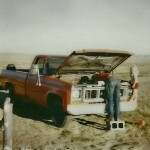
 For as long as I have known my husband, Bob Schulenberg, he has attracted the little girls. It surprises me every time I see it happen, although it probably shouldn’t by now. Bob got used to little girls when he became a daddy, first to our daughter, Corrie Petersen, and then our daughter, Amy Royce. They thought their daddy hung the moon, and I had to agree with them…he has always been a special kind of guy. Still, I can’t quite understand why it is always the little girls who tend to flock to Bob. It’s not little kids in general…it’s little girls. Of course, the little boys like him too…especially his grandsons, but the little boys are usually not the ones who come running up to Bob, or shyly wave at him, even when they don’t know him…that is the little girls. Of course, Bob would never pickup a little girl who was not the child of a friend, but that does not stop them from saying “Hi” and waving at him. Our own girls loved hanging out with their dad, and if he was working on a vehicle, they might be lifted up to stand on the bumper or they might be riding their bicycle nearby. Our grandchildren, Chris Petersen, Shai Royce, Caalab Royce, and Josh Petersen, also loved to be picked up by their Papa, and to this
For as long as I have known my husband, Bob Schulenberg, he has attracted the little girls. It surprises me every time I see it happen, although it probably shouldn’t by now. Bob got used to little girls when he became a daddy, first to our daughter, Corrie Petersen, and then our daughter, Amy Royce. They thought their daddy hung the moon, and I had to agree with them…he has always been a special kind of guy. Still, I can’t quite understand why it is always the little girls who tend to flock to Bob. It’s not little kids in general…it’s little girls. Of course, the little boys like him too…especially his grandsons, but the little boys are usually not the ones who come running up to Bob, or shyly wave at him, even when they don’t know him…that is the little girls. Of course, Bob would never pickup a little girl who was not the child of a friend, but that does not stop them from saying “Hi” and waving at him. Our own girls loved hanging out with their dad, and if he was working on a vehicle, they might be lifted up to stand on the bumper or they might be riding their bicycle nearby. Our grandchildren, Chris Petersen, Shai Royce, Caalab Royce, and Josh Petersen, also loved to be picked up by their Papa, and to this 
 day, he is their go-to mechanic when something is wrong with their vehicles, or anything else he can help with.
day, he is their go-to mechanic when something is wrong with their vehicles, or anything else he can help with.
One little girl in particular, Brooke Cardinal, who passed away at seven and who we miss very much, was very taken with Bob. Her grandpa, our friend Edd Cardinal ran the bowling alley in Casper, and both our family and his spent a lot of time down there. Brooke couldn’t wait for Bob to come in on bowling nights. She was waiting at the door for her hug. I even teased her mom, Dani Cardinal that Bob had a girlfriend. She was ready to kill him for cheating on me, until she found out that his “girlfriend” was her own little Brooke, who was about four years old then. Bob was forgiven for having a girlfriend, but the “girlfriends” didn’t stop there. Whenever we go to a restaurant and there is a little girl around, they always notice and wave to Bob. When we are out walking on the trail, at Sunrise Shopping Center, or the mall, little girls wave. And on New Year’s Eve, the next generation of girlfriends obviously arrived, when my grandniece, Aleesia Spethman took a shine to Bob, and hung around him much of the night.


Bob is a great guy, with a gentle heart, and that is one of the things that attracted me to him in the first place, but never in a million years would I have expected that every little girl within a mile radius of him would seek him out for the sole purpose of saying “Hi” and waving at him. It’s almost like he is a little girl magnet. Some day, maybe I’ll figure out just what it is about Bob that catches their eye, but until that day, and even beyond, I’m sure, I will have to share him with every little girl who comes into view, because he sure attracts them.

 Captain Charles Wilkes was an American naval officer, ship’s captain, and explorer. During an exploring expedition, authorized by the May 18, 1836 act of the Congress, Wilkes set out to explore the southern oceans. Congress didn’t expect his expedition to find anything amazing, but that is where they were wrong. His group set out in 1838, and it was during this expedition that Wilkes spotted the coast of Antarctica. The group had sailed around South America to the South Pacific, and after spotting Antarctica, decided to explore a 1,500 mile stretch of it’s eastern coast. The area later became known a Wilkes Land. In 1842, the expedition returned to New York, after having circumnavigated the globe. Wilkes wasn’t the first explorer to look at Antarctica, however. It was discovered by European and American explorers, and in the February 1821, American John Davis became the first person to land on the continent, coming in at Hughes Bay on the Antarctic Peninsula.
Captain Charles Wilkes was an American naval officer, ship’s captain, and explorer. During an exploring expedition, authorized by the May 18, 1836 act of the Congress, Wilkes set out to explore the southern oceans. Congress didn’t expect his expedition to find anything amazing, but that is where they were wrong. His group set out in 1838, and it was during this expedition that Wilkes spotted the coast of Antarctica. The group had sailed around South America to the South Pacific, and after spotting Antarctica, decided to explore a 1,500 mile stretch of it’s eastern coast. The area later became known a Wilkes Land. In 1842, the expedition returned to New York, after having circumnavigated the globe. Wilkes wasn’t the first explorer to look at Antarctica, however. It was discovered by European and American explorers, and in the February 1821, American John Davis became the first person to land on the continent, coming in at Hughes Bay on the Antarctic Peninsula.
Over the next century, many nations, including the United States, wanted to stake their territorial claims to portions of the frigid continent. I’m sure they all had the same idea for its use. Obviously, it was not going to be a place where people were going to live for any length of time…at least not at first. Scientists do spend quite a bit of time there now, but back then, the necessary facilities and equipment were not available.
Finally, in the 1930s, conflicting claims finally led to international rivalry, and the United States, which led the world in the establishment of scientific bases, enacted an official policy of making no territorial claims while recognizing no other nation’s claims. While it didn’t immediately solve the conflict then, it probably set in 
 motion, the 1959 Antarctic Treaty that made Antarctica an international zone, set guidelines for scientific cooperation, and prohibited military operations, nuclear explosions, and the disposal of radioactive waste on the continent. It’s sometimes strange to think about a continent that has really no owner, or rather is owned by the world, and yet even in modern times we have another such place…the International Soace Station. It’s nice to know that there are some things that we can share globally and actually get along.
motion, the 1959 Antarctic Treaty that made Antarctica an international zone, set guidelines for scientific cooperation, and prohibited military operations, nuclear explosions, and the disposal of radioactive waste on the continent. It’s sometimes strange to think about a continent that has really no owner, or rather is owned by the world, and yet even in modern times we have another such place…the International Soace Station. It’s nice to know that there are some things that we can share globally and actually get along.
 As the door closes on past eras of history, some things only exist in the memories of the people who lived it, and some things only exist in books or other writings. That doesn’t mean that they totally cease to exist, however. There are parts of the past that are still there…hidden, sometimes just under the surface, and sometimes a little way beneath the surface. Sometimes, there are clues on the surface, and other times, all you might have is a general location. Such is the case with Fort San Juan in western North Carolina. In 1566, Spanish explorer Juan Pardo began the first of two expeditions along the southeast coast of North America, establishing a series of forts in modern day South Carolina. The following year, Pardo travelled west, journeying almost 300 miles into what is now North Carolina. There, Pardo and his men constructed Fort San Juan and a small cluster of houses. Pardo named the settlement Cuenco, after his Spanish hometown.
As the door closes on past eras of history, some things only exist in the memories of the people who lived it, and some things only exist in books or other writings. That doesn’t mean that they totally cease to exist, however. There are parts of the past that are still there…hidden, sometimes just under the surface, and sometimes a little way beneath the surface. Sometimes, there are clues on the surface, and other times, all you might have is a general location. Such is the case with Fort San Juan in western North Carolina. In 1566, Spanish explorer Juan Pardo began the first of two expeditions along the southeast coast of North America, establishing a series of forts in modern day South Carolina. The following year, Pardo travelled west, journeying almost 300 miles into what is now North Carolina. There, Pardo and his men constructed Fort San Juan and a small cluster of houses. Pardo named the settlement Cuenco, after his Spanish hometown.
In 2013, a team of archeologists announced the discovery of the remains of a long lost 16th century Spanish garrison in western North Carolina that predates the earliest English settlements in North America by decades. Established in 1567, Fort San Juan was just one of at least six military installations built by the Spanish across the Appalachian mountain range, stretching from the coast of South Carolina to eastern Tennessee, and the only one of the forts scientists have located so far. Because Fort San Juan was established in 1567, time had taken its toll, and the information about it’s location was scarce, as was any visible trace of its location. Fort San Juan was one of at least six military installations that were built by the Spanish across the Appalachian mountain range, stretching from the coast of South Carolina to eastern Tennessee…and the only one of the  forts scientists have been able to locate so far. In the summer of 2013, a team of archeologists announced the discovery of the fort’s remains.
forts scientists have been able to locate so far. In the summer of 2013, a team of archeologists announced the discovery of the fort’s remains.
Archaeological work has been underway for years, revealing artifacts that suggested a Spanish settlement might have been there. During the summer of 2013, archaeologists affiliated with the University of Michigan, Tulane University and Warren Wilson College excitedly announced that they had discovered evidence of a defensive moat and other remains, definitive evidence of Fort San Juan. Nearly a decade ago, archeologists had found evidence of the soldier’s housing at Cuenco, but had been had not been able to locate the fort itself. The summer of 2013 changed all that, and was in fact it was completely by accident. The team, comprised of members from the University of Michigan, New Orleans’s Tulane University and Warren Wilson College in Asheville, North Carolina, was actually researching the Mississippian built mud mounds at the Joara site when they stumbled upon evidence of the remains of the fort. An initial dig turned up soil disturbances at the site that didn’t fit with what they expected. The team brought in a magnetometer to x-ray the subsurface. This 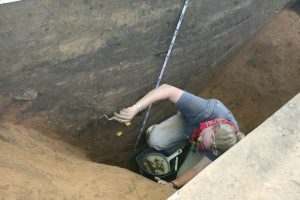 allowed them to identify the outlines of the moat was believed to have surrounded the garrison. Additional large scale excavations revealed its shape and size. A V-shaped area 5.5 feet deep, 12 to 15 feet across and up to 100 feet in length. In addition to the moat, the team recovered personal items belonging to the Spanish soldiers who lived and died at the fort, including pottery shards, nails, tacks, and iron hooks used for fastening clothing and swords. They also believe they located the gravel entry path into the garrison and the possible location of the strong house in a corner of the fort, where Spanish soldiers would have stored tools and weaponry. The group plans further excavations of the site next year.
allowed them to identify the outlines of the moat was believed to have surrounded the garrison. Additional large scale excavations revealed its shape and size. A V-shaped area 5.5 feet deep, 12 to 15 feet across and up to 100 feet in length. In addition to the moat, the team recovered personal items belonging to the Spanish soldiers who lived and died at the fort, including pottery shards, nails, tacks, and iron hooks used for fastening clothing and swords. They also believe they located the gravel entry path into the garrison and the possible location of the strong house in a corner of the fort, where Spanish soldiers would have stored tools and weaponry. The group plans further excavations of the site next year.

